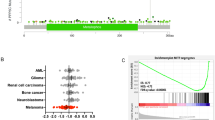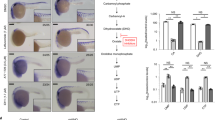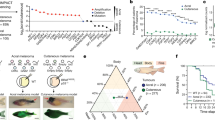Abstract
Melanoma is a tumour of transformed melanocytes, which are originally derived from the embryonic neural crest. It is unknown to what extent the programs that regulate neural crest development interact with mutations in the BRAF oncogene, which is the most commonly mutated gene in human melanoma1. We have used zebrafish embryos to identify the initiating transcriptional events that occur on activation of human BRAF(V600E) (which encodes an amino acid substitution mutant of BRAF) in the neural crest lineage. Zebrafish embryos that are transgenic for mitfa:BRAF(V600E) and lack p53 (also known as tp53) have a gene signature that is enriched for markers of multipotent neural crest cells, and neural crest progenitors from these embryos fail to terminally differentiate. To determine whether these early transcriptional events are important for melanoma pathogenesis, we performed a chemical genetic screen to identify small-molecule suppressors of the neural crest lineage, which were then tested for their effects on melanoma. One class of compound, inhibitors of dihydroorotate dehydrogenase (DHODH), for example leflunomide, led to an almost complete abrogation of neural crest development in zebrafish and to a reduction in the self-renewal of mammalian neural crest stem cells. Leflunomide exerts these effects by inhibiting the transcriptional elongation of genes that are required for neural crest development and melanoma growth. When used alone or in combination with a specific inhibitor of the BRAF(V600E) oncogene, DHODH inhibition led to a marked decrease in melanoma growth both in vitro and in mouse xenograft studies. Taken together, these studies highlight developmental pathways in neural crest cells that have a direct bearing on melanoma formation.
This is a preview of subscription content, access via your institution
Access options
Subscribe to this journal
Receive 51 print issues and online access
$199.00 per year
only $3.90 per issue
Buy this article
- Purchase on Springer Link
- Instant access to full article PDF
Prices may be subject to local taxes which are calculated during checkout




Similar content being viewed by others
References
Davies, H. et al. Mutations of the BRAF gene in human cancer. Nature 417, 949–954 (2002)
Rubinstein, A. L., Lee, D., Luo, R., Henion, P. D. & Halpern, M. E. Genes dependent on zebrafish cyclops function identified by AFLP differential gene expression screen. Genesis 26, 86–97 (2000)
Luo, R., An, M., Arduini, B. L. & Henion, P. D. Specific pan-neural crest expression of zebrafish Crestin throughout embryonic development. Dev. Dyn. 220, 169–174 (2001)
Bakos, R. M. et al. Nestin and SOX9 and SOX10 transcription factors are coexpressed in melanoma. Exp. Dermatol. 19, e89–e94 (2010)
Boiko, A. D. et al. Human melanoma-initiating cells express neural crest nerve growth factor receptor CD271. Nature 466, 133–137 (2010)
DiscoveryGate. 〈https://www.discoverygate.com/〉 (2008)
McLean, J. E., Neidhardt, E. A., Grossman, T. H. & Hedstrom, L. Multiple inhibitor analysis of the brequinar and leflunomide binding sites on human dihydroorotate dehydrogenase. Biochemistry 40, 2194–2200 (2001)
Kaplan, M. J. Leflunomide Aventis Pharma. Curr. Opin. Investig. Drugs 2, 222–230 (2001)
Bixby, S., Kruger, G. M., Mosher, J. T., Joseph, N. M. & Morrison, S. J. Cell-intrinsic differences between stem cells from different regions of the peripheral nervous system regulate the generation of neural diversity. Neuron 35, 643–656 (2002)
Molofsky, A. V. et al. Bmi-1 dependence distinguishes neural stem cell self-renewal from progenitor proliferation. Nature 425, 962–967 (2003)
Löffler, M., Jockel, J., Schuster, G. & Becker, C. Dihydroorotat-ubiquinone oxidoreductase links mitochondria in the biosynthesis of pyrimidine nucleotides. Mol. Cell. Biochem. 174, 125–129 (1997)
Keegan, B. R. et al. The elongation factors Pandora/Spt6 and Foggy/Spt5 promote transcription in the zebrafish embryo. Development 129, 1623–1632 (2002)
Krishnan, K., Salomonis, N. & Guo, S. Identification of Spt5 target genes in zebrafish development reveals its dual activity in vivo . PLoS ONE 3, e3621 (2008)
Guo, S. et al. A regulator of transcriptional elongation controls vertebrate neuronal development. Nature 408, 366–369 (2000)
Wada, T. et al. DSIF, a novel transcription elongation factor that regulates RNA polymerase II processivity, is composed of human Spt4 and Spt5 homologs. Genes Dev. 12, 343–356 (1998)
Rahl, P. B. et al. c-Myc regulates transcriptional pause release. Cell 141, 432–445 (2010)
Chen, Y. et al. Integration of genome and chromatin structure with gene expression profiles to predict c-MYC recognition site binding and function. PLOS Comput. Biol. 3, e63 (2007)
Hong, S. K., Tsang, M. & Dawid, I. B. The mych gene is required for neural crest survival during zebrafish development. PLoS ONE 3, e2029 (2008)
Aoki, T., Morris, H. P. & Weber, G. Regulatory properties and behavior of activity of carbamoyl phosphate synthetase II (glutamine-hydrolyzing) in normal and proliferating tissues. J. Biol. Chem. 257, 432–438 (1982)
Graves, L. M. et al. Regulation of carbamoyl phosphate synthetase by MAP kinase. Nature 403, 328–332 (2000)
Tsai, J. et al. Discovery of a selective inhibitor of oncogenic B-Raf kinase with potent antimelanoma activity. Proc. Natl Acad. Sci. USA 105, 3041–3046 (2008)
Ng, S. B. et al. Exome sequencing identifies the cause of a mendelian disorder. Nature Genet. 42, 30–35 (2010)
Nguyen, C. T., Langenbacher, A., Hsieh, M. & Chen, J. N. The PAF1 complex component Leo1 is essential for cardiac and neural crest development in zebrafish. Dev. Biol. 341, 167–175 (2010)
Mueller, D. et al. Misguided transcriptional elongation causes mixed lineage leukemia. PLoS Biol. 7, e1000249 (2009)
Bai, X. et al. TIF1γ controls erythroid cell fate by regulating transcription elongation. Cell 142, 133–143 (2010)
Wheeler, G. N. & Brandli, A. W. Simple vertebrate models for chemical genetics and drug discovery screens: lessons from zebrafish and Xenopus . Dev. Dyn. 238, 1287–1308 (2009)
Schiff, M. H., Strand, V., Oed, C. & Loew-Friedrich, I. Leflunomide: efficacy and safety in clinical trials for the treatment of rheumatoid arthritis. Drugs Today (Barc.) 36, 383–394 (2000)
Flaherty, K. T. et al. Inhibition of mutated, activated BRAF in metastatic melanoma. N. Engl. J. Med. 363, 809–819 (2010)
Acknowledgements
We thank G. Bollag and P. Lin for supplying PLX4720. The melanoma xenografts were performed with the assistance of T. Venezia-Bowman. In situ hybridization probes for crestin were supplied by P. Henion. We thank S. Lacadie, C. Ceol, Y. Houvras, T. Bowman, X. Bai and R. Field for discussions and/or comments on the manuscript. This work was supported by the Howard Hughes Medical Institute and the National Cancer Institute (National Institutes of Health) (L.I.Z.), Aid for Cancer Research, the American Society for Clinical Oncology and the National Institute of Arthritis and Musculoskeletal and Skin Diseases (National Institutes of Health) (R.M.W.). M.L.T. was a Biotechnology and Biological Sciences Research Council/Pfizer Industrial CASE award recipient.
Author information
Authors and Affiliations
Contributions
R.M.W. and L.I.Z. planned the project. The chemical screen was performed by R.M.W., S.R., J.C., F.C., C.J.B., H.K.L. and S.D. The Xenopus work and initial identification of NSC210627 was performed by M.L.T. in the laboratory of G.N.W. The mbp:mCherry work was performed by R.M.W. and C.K. The human DHODH assay was performed by M.K. at Genzyme. The rat neural crest work was performed by J.M. in the laboratory of S.M. The ChIP-seq experiments and data analysis were performed by P.B.R. and C.Y.L. in the laboratory of R.A.Y. The ChIP-PCR assays were performed by P.B.R., R.M.W. and E.L. The zebrafish elongation and melanoma assays were performed by R.M.W. and J.C. Statistical analysis was performed by D.N. Human melanoma tissue microarray analysis was performed by S.G. All authors discussed the results and commented on the manuscript.
Corresponding author
Ethics declarations
Competing interests
L.I.Z. is a founder and stockholder of Fate Therapeutics and a scientific adviser for Stemgent.
Supplementary information
Supplementary Information
This file contains Supplementary Figures 1-16 with legends, legends for Supplementary Tables 1-6 and Supplementary Methods with additional references. (PDF 1700 kb)
Supplementary Table 1
GSEA analysis showing genes enriched between BRAFV600E;p53‐/‐ embryos and tumors - see Supplementary Information file for full legend. (XLS 910 kb)
Supplementary Table 2
Neural crest genes affected by leflunomide - see Supplementary Information file for full legend. (XLS 134 kb)
Supplementary Table 3
GSEA analysis comparing leflunomide treated embryos to the spt5sk8 mutant line at 24hpf - see Supplementary Information file for full legend. (XLS 612 kb)
Supplementary Table 4
qRT‐PCR results analyzing 5’ or 3’ transcripts in 24hpf embryos treated with either leflunomide (6.5μM) or DMSO control - see Supplementary Information file for full legend. (XLS 12 kb)
Supplementary Table 5
ChIP‐seq results in the presence of leflunomide in A375 and MAMLE‐3M cell lines - see Supplementary Information file for full legend. (XLS 3373 kb)
Supplementary Table 6
Microarray analysis of A375 melanoma cells treated with leflunomide 25μM for 3 days - see Supplementary Information file for full legend. (XLS 534 kb)
Rights and permissions
About this article
Cite this article
White, R., Cech, J., Ratanasirintrawoot, S. et al. DHODH modulates transcriptional elongation in the neural crest and melanoma. Nature 471, 518–522 (2011). https://doi.org/10.1038/nature09882
Received:
Accepted:
Published:
Issue Date:
DOI: https://doi.org/10.1038/nature09882
This article is cited by
-
GREB1 isoform 4 is specifically transcribed by MITF and required for melanoma proliferation
Oncogene (2023)
-
Functional analysis of recurrent CDC20 promoter variants in human melanoma
Communications Biology (2023)
-
Developmental exposure to domoic acid targets reticulospinal neurons and leads to aberrant myelination in the spinal cord
Scientific Reports (2023)
-
An epigenetic switch controls an alternative NR2F2 isoform that unleashes a metastatic program in melanoma
Nature Communications (2023)
-
Nucleotide metabolism: a pan-cancer metabolic dependency
Nature Reviews Cancer (2023)
Comments
By submitting a comment you agree to abide by our Terms and Community Guidelines. If you find something abusive or that does not comply with our terms or guidelines please flag it as inappropriate.



